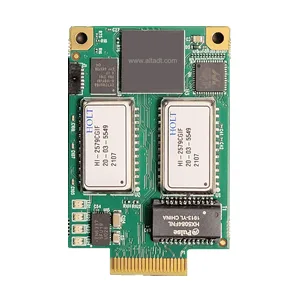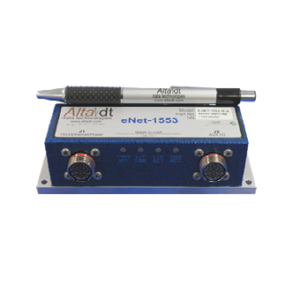The MEZ-E1553 is a compact, rugged mezzanine module designed for seamless integration of 1-2 dual redundant MIL-STD-1553 channels with a real-time Ethernet UDP interface. Measuring 36.25x56mm with a max height of 8.2mm, it supports commercial or industrial extended temperature ranges (-40 to 85°C). Compliant with 1553A/B/C standards, it includes full reference schematics, design guidelines, 3-D STEP files, and ESS test examples. The module features signal capture for cable troubleshooting and cybersecurity modeling, auto 1553-Ethernet bridging, and AltaAPI SDK for flexible development across various operating systems, including DO-178 systems.
Key Features
- 1-2 Dual Redundant 1553 Channels: Independent channels with dual or full function (BC/mRT/Mon) capability.
- Real-Time Ethernet UDP Interface: Supports 10/100/1000 Mbps for efficient data transfer.
- Signal Capture on First Channel: Enables cable troubleshooting and cybersecurity modeling.
- Auto 1553-Ethernet Bridging: Bus monitor functionality without programming.
- Compact Design: 36.25x56mm, 8.2mm max height, ideal for embedded systems.
- Extended Temperature Range: Operates in -40 to 85°C with industrial components.
- AltaAPI SDK: Compatible with multiple OS, including DO-178 systems, for easy integration.
- Avionics Discretes: 6 bi-directional discretes for MIL-1760 RT addressing, plus one RS-485 discrete.
- IRIG-B and Clock Support: RX PAM or RX/TX PPS external clock for precise timing.
- Comprehensive Support: Includes full schematics, 3-D STEP files, and ESS test examples.
Applications
The MEZ-E1553 is tailored for defense and aerospace applications, offering robust MIL-STD-1553 communication for mission-critical systems. Its compact size and rugged design make it ideal for embedded avionics in fighter jets, UAVs, and missile systems, ensuring reliable data transfer in harsh environments. The signal capture feature supports cybersecurity modeling, critical for securing military networks against threats. Auto 1553-Ethernet bridging simplifies integration into command and control systems, while the AltaAPI SDK enables rapid development for radar, navigation, and communication systems, enhancing interoperability and performance in defense platforms.







